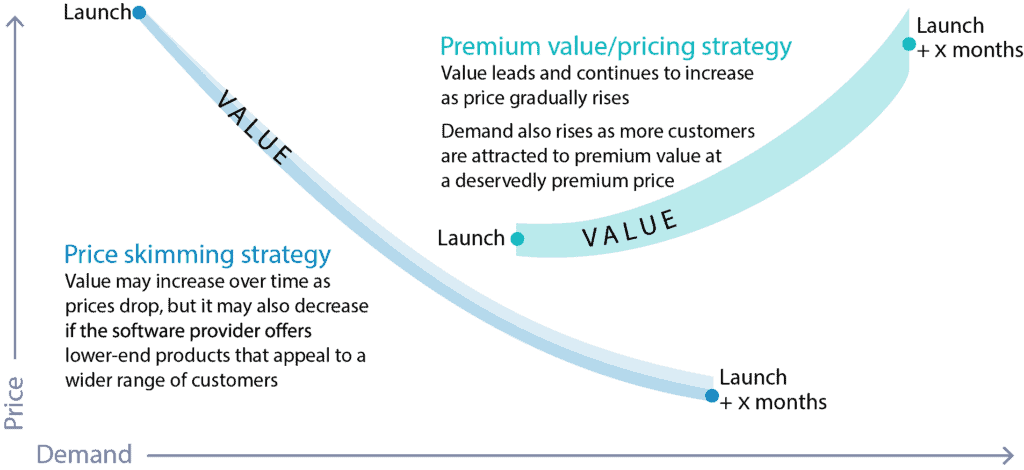Will a premium pricing strategy increase your revenue and profits?
In online discussions of pricing strategies, you’ll often see strong assertions about the benefits of premium pricing. Higher prices, some say, are a fast, direct way of boosting revenues and profits. Supposedly they increase buyer perception of a product’s relative value in the marketplace. A higher price might even act as a moat around products, making it harder for other providers to compete.
But while there are plenty of B2C examples of successful premium pricing, does it work as well for B2B software?
- Will a premium pricing strategy increase your revenue and profits?
- Does premium pricing work for B2B software?
- What is premium pricing?
- Why use premium pricing?
- Do B2B buyers believe premium pricing means higher quality?
- Which is better: premium list price or premium net price?
- Does your premium pricing model scale?
- What are the biggest risks of premium pricing?
- More premium pricing risks
- Is premium pricing a competitive advantage?
- Is price skimming the same as premium pricing?
- Three keys to successful premium pricing of B2B software
Does premium pricing work for B2B software?
My observation is that premium pricing in B2B software markets often delivers disappointing results. A handful of companies, including Salesforce, HubSpot and Adobe, have been successful with this method, but they’ve arrived at their elite positions through long-term product development and monetization journeys.
In contrast, many B2B software companies trying to do premium pricing don’t have the necessary context and characteristics. Decisions to go premium may be based on copying or one-upping a competitor’s pricing. Some companies borrow B2C pricing strategies without adjusting for the more complex ways value is perceived and derived in B2B markets.
The results of poorly conceived and executed premium pricing aren’t pretty: Revenues drop as the demand curve shifts. Profit margins climb, but profits sink. Customer loyalty and relationship lifetime value take a hit.
But there is a way to do premium pricing right for B2B software—and achieve the results you’re aiming for. I’ll get to that, but first the basics.
What is premium pricing?
Premium pricing is a monetization strategy that deliberately sets list prices higher than those of competitors or at par with an already premium-priced competitor.
Why use premium pricing?
In B2C markets, companies often price their products at premiums to create a market perception of higher quality and create a sense of exclusivity. These strategies aim to attract buyers willing to pay more “for the best.”
In B2B software markets, some assume a similar direct relationship between price and perception, but often this is not the case. Other market dynamics—such as a bias toward disruptive innovations that simplify/undercut the status quo and deliver higher quality with lower cost—can intervene, changing value equations.
Do B2B buyers believe premium pricing means higher quality?
While many consumers evaluate the quality of products based on price, B2B buyers are generally savvier. Reputation for quality figures into decisions, but price-related status and exclusivity play less of a role in purchase decisions. More essential criteria include fit between product functionality and business needs, how the product will contribute to operational excellence and the business value buyer organizations can derive using the software.
Which is better: premium list price or premium net price?
Premium pricing is commonly thought of in terms of list price. But B2B buyers are really trying to calculate the relationship between your net price—what they’re actually going to pay—and your software’s business value to their organization.
Because of deep discretionary discounting, companies posing as premium providers often end up selling their software at bargain basement prices. While buyers may be thrilled to get these deals, the experience could undermine their perception of business value and before long, word of mouth may affect B2B market perception.
To avoid this situation, design a premium pricing model with a systematic framework for incentives, including volume discounts. In other words, agree on your premium net prices and enforce them during the sales process. Train your sales team in pricing fluency—the ability to readily tour buyers through how your pricing works and demonstrate what the net price would be under various scenarios.
Does your premium pricing model scale?
On your website and anywhere else you quote list prices, communicate that your pricing scales, enabling business customers to earn better deals by purchasing more. If you fail to share this essential information, potential buyers may cross your software off their evaluation lists early on. Multiplying your premium list price times the number of units, they arrive at a figure that’s not only premium-priced but ridiculously overpriced.
And even if you get to the point of offering the business buyer a great deal on their initial purchase, they may still be worried about the future. At some point, if they want to add capacity, expand usage, increase consumption or transaction volume, or buy additional packages, will your premium prices be out of reach?
What are the biggest risks of premium pricing?
Here’s our take on the biggest risks of premium pricing in B2B software markets:
Flattening revenues and profits. Higher prices can impact demand. Without an understanding of the relationship between your price points and demand curve, you could implement a premium pricing strategy that increases deal margins but reduces deal number and size. Cost of sales and time to close climb, revenues and profits drop.
Falling prey to more innovative competitors. A higher priced premium software product can easily be picked off by an innovative fast-mover that offers similar capabilities and value but is lower priced and more attuned to today’s market conversation.
Never getting product off the ground. Launching with premium pricing is extremely risky unless a B2B product is clearly superior in a way that resonates with business buyers. New software usually offers only a subset of envisioned capabilities. Even though premium pricing may be justified by what the software will become, setting the price point too high too early could impede sales to such an extent that the product never gets the chance to unfold its wings.
More premium pricing risks
Being left off buyer evaluation lists. See the discussion above about scaling premium pricing models.
Preventing buyers from seeing your software in their future. See the discussion above about scaling premium pricing models.
Looking like an overpriced add-on. Take extra care with premium pricing if your B2B product relies on other products to deliver it. The danger is that business buyers may think you’re trying to take advantage of the fact they’ve already bought the base product, price-gouging them for the next step in functionality.
A tier too far. Creating a premium product tier can also be tricky. Too often, B2B software companies try to justify a premium price by loading the tier with all kinds of stuff—marginal features, excess storage capacity, APIs galore—most users don’t need. After much maneuvering by buyers for partial-use discounts, the result is that your premium list-priced software goes for bargain basement net prices. Also, customers purchasing the same set of products at similar volumes may end up paying wildly different prices—an injustice that gets around via word of mouth and violates Market Fairness Pricing principles. (While violating these principles is the norm in today’s software “horse trading” environment, the costs and downside risks are quite severe. Get educated on the cons of this approach and have the courage to rise above it.)
Is premium pricing a competitive advantage?
Premium pricing can be a competitive advantage for B2B software—but, I would argue, only when your product also occupies the premium value position in the market.
A solid initial strategy is to provide the best business value at an affordable price. Then incrementally, as you continue to deliver more value over time, test small price increases to explore and better understand your demand curve. This is a reliable method of conducting willingness-to-pay research based on what customers do, not just what they say. Ultimately you arrive at the sweet spot: provider of premium value at a deservedly premium price.
Is price skimming the same as premium pricing?
In price skimming, you set a premium price point—but only at the beginning of a product’s life. Once you’ve saturated the market of customers willing to pay the premium, you lower your price to expand your customer base and stay competitive. Some companies repeat the process, skimming off successive layers of customers based on price sensitivity.
This strategy is 180 degrees opposite our recommended process, where you lead with premium value at an affordable price and gradually take the premium value/premium price position. We think this value-first approach is a more reliable, controllable method for B2B software markets, where purchasing processes tend to be more rational than emotional, and incumbents are always vulnerable to disruptive innovators.

Three keys to successful premium pricing of B2B software
- Develop your own premium pricing model—don’t copy. When you copy the pricing of competitors or other companies, you are cutting and pasting something out of context into your business. You’re also inadvertently copying the source company’s risk, which might not align with other aspects of your business, producing unexpected impacts on your operations.
- Design pricing as part of a coherent monetization strategy, including licensing, packaging and a structured framework of incentives. All of these components work together and are based on a thorough understanding of how specific classes of customers use your software in similar ways to derive business value. In other words, your strategy is anchored in operational realities rather than based on ephemeral perceptions.
- Keep refining your pricing as you build product value. Premium pricing is not a set-once method; it’s an ongoing business journey. Ultimately, whether you launch with a premium price point or arrive at it over time, your software must be worthy of that position.
To find out more about pricing strategies for B2B software, keep reading this blog, or contact me: chrismele@softwarepricing.com.




